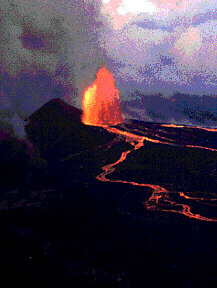This is an image of Mauna Kea erupting.
Click on image for full size
Image from: U.S. Geological Survey
Shield Volcanoes
Shield volcanoes can grow to be very big. In fact, the oldest continental regions of Earth may be the remains of ancient shield volcanoes.
Unlike the composite volcanoes which are tall and thin, shield volcanoes are tall and broad, with flat, rounded shapes. The Hawaiian volcanoes exemplify the common type of shield volcano. They are built by countless outpourings of lava that advance great distances from a central summit vent or group of vents. The outpourings of lava are typically not accompanied by pyroclastic material, which make the shield volcanoes relatively safe, as shown in this picture of scientists monitoring the eruption.
Mauna Loa, the largest of the shield volcanoes, is 13,677 feet above sea level, which means it rises over 28,000 feet above the deep ocean floor, and would be the worlds tallest mountain if much of it were not underwater.
Famous shield volcanoes include Mauna Loa, Kilauea, (two of the world's most active volcanoes), andOlympus Mons of Mars.
You might also be interested in:

This image shows scientists monitoring the changing shape of a shield volcano with lasers. Scientist also use other tools like remote sensing to measure volcanoes.
...more
Ash is made of millions of tiny fragments of rock and glass formed during a volcanic eruption. Volcanic ash particles are less than 2 mm in size and can be much smaller. Volcanic ash forms in several ways
...more
Cinder cones are simple volcanoes which have a bowl-shaped crater at the summit and only grow to about a thousand feet, the size of a hill. They usually are created of eruptions from a single opening,
...more
Lava can move in broad flat lava flows, or it can move through tight channels or tubes. Lava flows tend to cool quickly and flow slowly. The fastest lava outside of channels moves at about 6 mi/hr an easy
...more
Plates at our planet’s surface move because of the intense heat in the Earth’s core that causes molten rock in the mantle layer to move. It moves in a pattern called a convection cell that forms when
...more
Many kinds of surface features are clues that our lithosphere is sliding. Two types of features can form when plates move apart. At mid ocean ridges, the bottom of the sea splits apart and new crust is
...more
Magma consists of remelted material from Earth's crust and fresh material from other regions near the Earth's surface. When magma is erupted onto the surface in the form of lava, it becomes silicate rock.
...more















